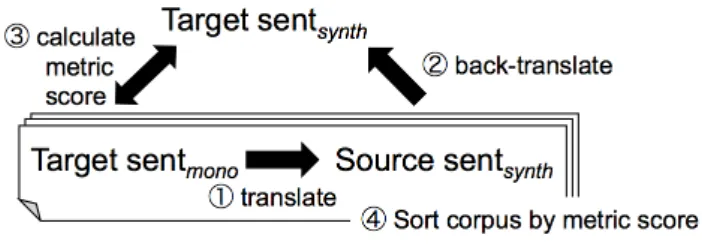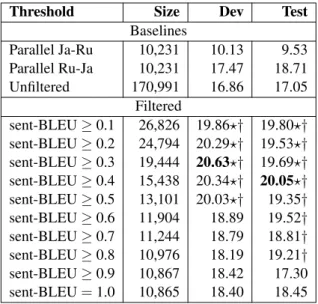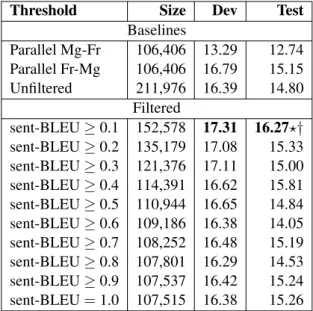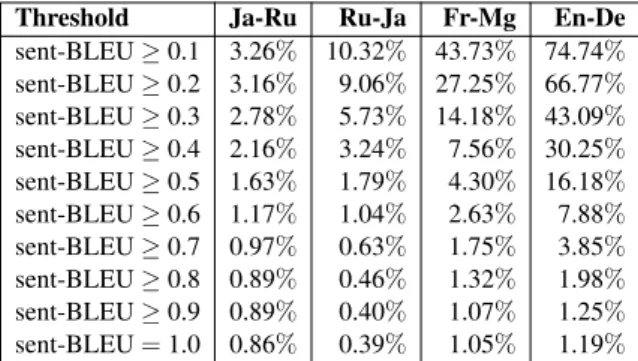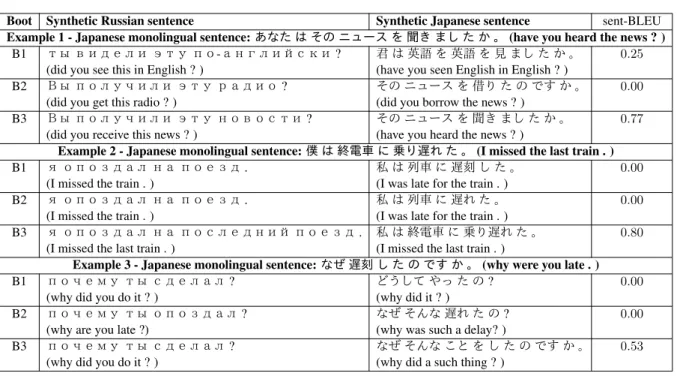Improving Low-Resource Neural Machine Translation
with Filtered Pseudo-parallel Corpus
Aizhan Imankulova and Takayuki Sato and Mamoru Komachi
Tokyo Metropolitan University
{imankulova-aizhan, sato-takayuki}@ed.tmu.ac.jp, komachi@tmu.ac.jp
Abstract
Large-scale parallel corpora are indis-pensable to train highly accurate ma-chine translators. However, manually constructed large-scale parallel corpora are not freely available in many lan-guage pairs. In previous studies, training data have been expanded using a pseudo-parallel corpus obtained using machine translation of the monolingual corpus in the target language. However, in low-resource language pairs in which only low-accuracy machine translation systems can be used, translation quality is reduces when a pseudo-parallel corpus is used naively. To improve machine translation performance with low-resource language pairs, we propose a method to expand the training data effectively via filtering the pseudo-parallel corpus using a quality es-timation based on back-translation. As a result of experiments with three language pairs using small, medium, and large par-allel corpora, language pairs with fewer training data filtered out more sentence pairs and improved BLEU scores more significantly.
1 Introduction
A large-scale parallel corpus is an essential re-source for training statistical machine translation (SMT) and neural machine translation (NMT) sys-tems. Creating a high-quality large-scale parallel corpus requires time, money and professionals to translate a large amount of texts. As a result, many of the existing large-scale parallel corpora are lim-ited to specific languages and domains. In con-trast, large monolingual corpora are easier to ob-tain.
Figure 1: Creating and filtering a pseudo-parallel corpus using back-translation.
Various approaches have been proposed to cre-ate a pseudo-parallel corpus from a monolingual corpus. For example, Zhang et al. (2016) pro-posed a method to generate a pseudo-parallel cor-pus based on a monolingual corcor-pus of the source language and its automatic translation. Sennrich et al. (2016) obtained substantial improvements by automatically translating a monolingual cor-pus of the target language into the source lan-guage, which they refer to as synthetic, and treat-ing the obtained pseudo-parallel corpus as addi-tional training data. They used monolingual data of the target language to learn the language model more effectively. However, they experimented on language pairs where relatively large-scale paral-lel corpora are available. Thus, they did not need to fully exploit the training corpus nor care about the quality of the pseudo-parallel corpus.
Therefore, we propose a method to create a pseudo-parallel corpus by back-translating and fil-tering a monolingual corpus in the target lan-guage for low-resource lanlan-guage pairs. If the tar-get sentence and its back-translation are similar, we assume that the synthetic source sentence is appropriate regarding its monolingual target sen-tence and can be included into the filtered pseudo-parallel corpus. The quality of the pseudo-pseudo-parallel corpus is especially important because low-quality
parallel sentences will degrade NMT performance more than SMT. Our motivation is to filter out low-quality synthetic sentences that might be included in such a pseudo-parallel corpus to obtain a high-quality pseudo-parallel corpus for low-resource language pairs. To the best of our knowledge, this is the first attempt to (1) filter a pseudo-parallel corpus using back-translation and (2) bootstrap NMT.
The main contributions of our research are as follows:
• We filter a pseudo-parallel corpus us-ing sentence-level similarity metric, in our case sentence-level BLEU (Lin and Och, 2004a,b), and obtain a trainable high-quality pseudo-parallel corpus.
• We show that the proposed filtering method is useful for low-resource language pairs, al-though bootstrapping does not outperform the proposed filtering method significantly. • We will release the obtained filtered
pseudo-parallel corpora1.
In this study, we used Japanese↔Russian as low-resource language pairs, French→Malagasy as medium-resource language pairs and German→English as high-resource language pairs. We show that a previous state-of-the-art method (Sennrich et al., 2016) is effective for high-resource language pairs; however, in the case of low-resource language pairs, it is more effective to use a filtered pseudo-parallel corpus as additional training data.
The remainder of this paper is organized as follows: Section 2 discusses previous studies re-lated to improving low-resource machine trans-lation systems; Section 3 outlines the proposed method for filtering a pseudo-parallel corpus and bootstrapping NMT; Sections 4 and 5 evaluate the proposed model; and Section 6 discusses the re-sults. Conclusions and suggestions for future work are presented in Section 7.
2 Related Work
To address the data sparsity problem, there are many methods that use source language mono-lingual data to improve translation quality (Ueff-ing et al., 2007; Shwenk, 2008; Bertoldi and Federico, 2009; Hsieh et al., 2013; Zhang et al., 2016). Specifically, Bertoldi and Federico
1 https://github.com/aizhanti/filtered-pseudo-parallel-corpora
(2009) addressed the problem of domain adapta-tion by training a translaadapta-tion model from a gener-ated pseudo-parallel corpus cregener-ated from a mono-lingual in-domain corpus. Hsieh et al. (2013) cre-ate a pseudo-parallel corpus from patterns learned from source and monolingual target in-domain corpora for cross-domain adaptation. They manu-ally conducted filtration of “relatively more accu-rate” translated sentences and used them to revise the language model. Similarly, we use a pseudo-parallel corpus created by translating a monolin-gual corpus from the target language rather than the source language; however we apply automatic filtering to the obtained pseudo-parallel corpus.
Data filtering is often used in domain adap-tation (Moore and Lewis, 2010; Axelrod et al., 2011) and phrase-based SMT systems. Sen-tences are extracted from large corpora to opti-mize the language model and the translation model (Wang et al., 2014; Yıldız et al., 2014). The work most closely related to our work is Yıldız et al. (2014), who build a quality estimator to obtain high-quality parallel sentence pairs and achieve better translation performance and reduce time-complexity with a small high-quality corpus. This method filters data by calculating similarity be-tween source and target sentences. In our work, we calculate similarity between monolingual and synthetic target sentences.
Recently, van der Wees et al. (2017) performed dynamic data selection during training an NMT. To sort and filter the training data, they used lan-guage models from the source and target sides of in-domain and out-of-domain data to calculate cross-entropy scores. However, we employ back-translation to filter data considering its meaning.
3 Improving Low-resource Neural Machine Translation (NMT) with Filtered Pseudo-parallel Corpus
In this paper, we propose a method of filtering a pseudo-parallel corpus used as additional training data by back-translating a monolingual corpus for low-resource language pairs. Then, we attempt to bootstrap an NMT model by iterating the filtering process until convergence.
3.1 Filtering
As shown in Figure 1, the proposed method has following steps:
1. Translate monolingual target sentences (Tar-get sentmono) using a model trained on par-allel corpus in target→source direction to produce synthetic source sentences (Source sentsynth). Here, we obtain an
“Unfil-tered” pseudo-parallel corpus as additional data without a filtration, similar to Sennrich et al. (2016).
2. Back-translate the synthetic source sentences using a model trained on parallel corpus in source→target direction to obtain a synthetic target sentences (Target sentsynth).
3. Calculate sentence-level similarity metric scores using the monolingual target sentences as reference and the synthetic target sen-tences as candidates.
4. Sort the monolingual target sentences and the corresponding synthetic source sentences by a descending order of sentence-level simi-larity metric scores and filter out sentences with low scores. The threshold is determined by the translation quality on the development set.
5. Use the filtered synthetic source sentences as the source side and the monolingual target sentences as the target side of the pseudo-parallel corpus; this is referred to as aFiltered
pseudo-parallel corpus as additional data.
3.2 Bootstrapping
Bootstrapping involves the following steps: 1. “Bootstrap 1”: we use a pseudo-parallel
cor-pus created using the“Parallel”model as ad-ditional data to train the seed NMT systems. 2. “Bootstrap 2”: we select the best model on
the development set from“Bootstrap 1”and train its target→source model. Here, we use target sentences from the pseudo-parallel
cor-Corpus Ru↔Ja Fr→Mg De→En
Parallel 10,231 106,406 4,535,522
Dev 500 1,000 3,000
Test 500 1,000 3,003
Mono target 75k↔167k 105,570 4,208,439
Table 1: Data statistics.
pus that have been filtered out in the previous iteration to train the best model. If there is no improvement over the previous iteration, ter-minate the bootstrapping process and return to theFilteredpseudo-parallel corpus and the translation model as output. Repeat.
Even if the monolingual target sentences remain the same, the synthetic source sentences are re-freshed at each iteration. In other words, the trans-lation quality of both the “Unfiltered” and “Fil-tered” pseudo-parallel corpus will be improved via the bootstrapping process until the termination criterion is met.
4 Experiments Using a Filtered Pseudo-parallel Corpus
4.1 Settings
We used the OpenNMT toolkit2 (Klein et al., 2017) to train all translation models. For the Russian↔Japanese and French→Malagasy exper-iments, we used the following parameters: the number of recurrent layers of the encoder and de-coder was 1, BiLSTM with concatenation, max-imum batch size was 32, and the optimization method was Adadelta. For the German→English experiments, OpenNMT default settings were used. The vocabulary size in all experiments was 50,000.
We tokenized and truecased French, English, German, and Russian sentences using Moses’ scripts. For Japanese sentences, we used MeCab 0.996 with the IPAdic dictionary3 for word seg-mentation. We eliminated duplicated sentences and sentences with more than 50 words for all lan-guages. We report BLEU scores (Papineni et al., 2002) to compare translation results. We used the Travatar toolkit (Neubig, 2013) to calculate the significance of differences between systems using bootstrap resampling (p< 0.05).
Threshold Size Dev Test Baselines
Parallel Ja-Ru 10,231 10.13 9.53 Parallel Ru-Ja 10,231 17.47 18.71 Unfiltered 170,991 16.86 17.05
Filtered
sent-LM≥0.1 168,572 18.65 18.01 sent-LM≥0.2 167,340 17.42 16.65 sent-LM≥0.3 165,166 18.42 16.85 sent-LM≥0.4 160,635 18.69 16.23 sent-LM≥0.5 150,974 17.82 17.28 sent-LM≥0.6 131,402 17.37 16.86 sent-LM≥0.7 95,573 17.69 17.54 sent-LM≥0.8 40,774 17.56 16.95 sent-LM≥0.9 11,542 18.13 17.22 sent-LM=1.0 10,232 18.38 16.93
(a) Bootstrap 1.
Threshold Size Dev Test
Baselines
B1 Parallel Ja-Ru 160,635 9.05 8.32 B1 Parallel Ru-Ja 160,635 18.69 16.23 B1 Unfiltered 170,991 17.03 17.75
Filtered
sent-LM≥0.1 161,261 16.92 17.63 sent-LM≥0.2 160,866 17.75 16.58 sent-LM≥0.3 160,704 18.29 18.33 sent-LM≥0.4 160,654 18.64 17.37 sent-LM≥0.5 160,640 18.29 17.63
(b) Bootstrap 2.
Table 2: Russian→Japanese translation BLEU scores. Sorting was performed using sent-LM score.
4.2 Dataset
The parallel corpora for low-resource Russian↔Japanese4 and for medium-resource French→Malagasy5 experiments were down-loaded from OPUS. For the medium-resource French-Malagasy language pair, we used the GlobalVoices corpus, which differs from the Tatoeba corpus used in the previous experiments. Note that the GlobalVoices corpus has more available parallel data (106,406 sentence pairs compared to 10,231).
We split the Tatoeba parallel corpus for the
4http://opus.lingfil.uu.se/Tatoeba.php 5http://opus.lingfil.uu.se/
GlobalVoices.php
Threshold Size Dev Test
Baselines
Parallel Ja-Ru 10,231 10.13 9.53 Parallel Ru-Ja 10,231 17.47 18.71 Unfiltered 170,991 16.86 17.05
Filtered
sent-BLEU≥0.1 26,826 19.86⋆† 19.80⋆†
sent-BLEU≥0.2 24,794 20.29⋆† 19.53⋆†
sent-BLEU≥0.3 19,444 20.63⋆† 19.69⋆†
sent-BLEU≥0.4 15,438 20.34⋆† 20.05⋆†
sent-BLEU≥0.5 13,101 20.03⋆† 19.35†
sent-BLEU≥0.6 11,904 18.89 19.52† sent-BLEU≥0.7 11,244 18.79 18.81† sent-BLEU≥0.8 10,976 18.19 19.21† sent-BLEU≥0.9 10,867 18.42 17.30 sent-BLEU=1.0 10,865 18.40 18.45
Table 3: Russian→Japanese translation BLEU scores. Sorting was performed using sent-BLEU score (Bootstrap 1). There is a significant differ-ence: ⋆: against “Parallel” baseline; †: against
“Unfiltered”baseline.
Russian↔Japanese experiments as follows: train-ing set, 10,231 sentences; development set, 500 sentences; and test set, 500 sentences. In addition, to perform Japanese→Russian→Japanese transla-tion for the Russian to Japanese experiment, we sampled an additional 167,600 Japanese mono-lingual sentences from Tatoeba. We also sam-pled 75,401 Russian monolingual sentences from Tatoeba for Japanese→Russian translation to fa-cilitate Russian→Japanese→Russian translation.
We performed experiments for the language pair French→Malagasy language pairs using the data from the GlobalVoices corpus. Parallel data were split as follows: training set, 106,406 sen-tences; development set, 1,000 sensen-tences; and test set, 1,000 sentences. Note that 105,570 Mala-gasy monolingual sentences from GlobalVoices were used to create a French→Malagasy pseudo-parallel corpus.
For the German→English experiments, we downloaded pre-trained German↔English mod-els and 4,535,522 parallel sentences provided by OpenNMT6 and used the OpenNMT settings to preprocess all data. We downloaded 4,208,439 German→English sentences from automatically back-translated monolingual data7 and translated the synthetic German side back to English using
6http://opennmt.net/Models/
Threshold Size Dev Test Baselines
B1 Parallel Ja-Ru 19,444 12.13 9.78 B1 Parallel Ru-Ja 19,444 20.63† 19.69† B1 Unfiltered 170,991 18.06 16.85
Filtered
sent-BLEU≥0.1 40,567 21.03† 21.01† sent-BLEU≥0.2 37,531 21.48† 19.20† sent-BLEU≥0.3 29,533 21.06† 20.69† sent-BLEU≥0.4 24,290 21.16† 21.08† sent-BLEU≥0.5 21,742 20.58† 21.57⋆† sent-BLEU≥0.6 20,478 19.93† 20.80† sent-BLEU≥0.7 19,920 20.46† 20.48† sent-BLEU≥0.8 19,726 20.78† 20.60† sent-BLEU≥0.9 19,626 20.38† 21.54⋆† sent-BLEU=1.0 19,623 21.23† 21.17⋆†
Table 4: Russian→Japanese translation BLEU scores. Sorting was performed using sent-BLEU score (Bootstrap 2).
the pre-trained German→English model to filter this pseudo-parallel corpus. We used newtest2013 (3,000 sentence pairs) as a development set and newtest2014 (3,003 sentence pairs) as a test set. Table 1 shows the data statistics.
4.3 Baselines
Sennrich et al. (2016) obtained additional training data by automatically translating monolingual tar-get sentences into the source language using their
“Parallel” baseline system. Our process differs from theirs in that we construct“Parallel” base-line machine translation systems in both directions using an available parallel corpus to obtain a fil-tered pseudo-parallel corpus.
Our baseline systems were as follows: 1) “Par-allel” systems that trained on a parallel corpus in both directions, which were used to create a pseudo-parallel corpus; or “B{1,2} Parallel”
in case of bootstrapping 2) “Unfiltered” system, which was trained on a concatenated parallel cor-pus with all pseudo-parallel corpora without filtra-tion; or“B{1,2} Unfiltered” in case of bootstrap-ping.
4.4 Sentence-level similarity metric
We used sentence-level BLEU (sent-BLEU) as a sentence-level similarity metric. The sent-BLEU scores were calculated using mteval-sentence of the mteval toolkit8. In Russian→Japanese
experi-8https://github.com/odashi/mteval
Threshold Size Dev Test
Baselines
B2 Parallel Ja-Ru 37,531 12.35 11.78 B2 Parallel Ru-Ja 37,531 21.48† 19.20† B2 Unfiltered 170,991 18.96 17.20
Filtered
sent-BLEU≥0.1 53,478 21.34† 19.10† sent-BLEU≥0.2 49,833 20.61† 19.99† sent-BLEU≥0.3 43,470 21.32† 20.59† sent-BLEU≥0.4 40,147 20.75† 20.16† sent-BLEU≥0.5 38,687 20.40† 18.65 sent-BLEU≥0.6 38,043 20.03 21.02⋆† sent-BLEU≥0.7 37,758 20.17† 20.23† sent-BLEU≥0.8 37,639 20.33† 20.61† sent-BLEU≥0.9 37,600 19.75 19.80† sent-BLEU=1.0 37,598 20.83† 20.62†
Table 5: Russian→Japanese translation BLEU scores. Sorting was performed using sent-BLEU score (Bootstrap 3).
ments, we compared the sent-BLEU scores, which require back-translation of the target monolingual data for the proposed filtration method, with a lan-guage model (sent-LM) that performs filtration by scoring only synthetic source sentences. We used the KenLM Language Model Toolkit9to build a 5-gram language model from 23,239,280 sentences from the Russian side of the Russian-English UN corpus (Ziemski et al., 2016).10. We also applied Kneser-Ney smoothing. To extract the scores, we normalized the language model log probability of the sentence to be between [0, 1] as in sent-BLEU using a feature scaling method.
Translation performance increases as the num-ber of parallel sentences increases (Koehn, 2002). For a pseudo-parallel corpus, however, translation performance does not necessarily increase with the number of sentences. To determine the ef-fects of the quantity and quality of the pseudo-parallel corpus in machine translation, we set thresholds with increment steps of 0.1. Thus, pseudo-parallel sentences included as additional data have sentence-level similarity scores greater or equal to some threshold (e.g., sentence-level BLEU≥ 0.1,..., sentence-level BLEU≥ 0.9, ...). Sentences scored and filtered by sentence-level similarity were used to train “Filtered” models. For example, sentences with sentence-level
Threshold Size Dev Test Baselines
Parallel Ru-Ja 10,231 17.47 18.71 Parallel Ja-Ru 10,231 10.13 9.53
Unfiltered 85,632 10.40 9.01
Filtered
sent-BLEU≥0.1 12,686 12.86⋆† 12.81⋆† sent-BLEU≥0.2 12,613 12.82⋆† 13.60⋆† sent-BLEU≥0.3 12,325 14.08⋆† 13.34⋆† sent-BLEU≥0.4 11,860 13.14⋆† 14.08⋆† sent-BLEU≥0.5 11,462 11.95⋆† 13.86⋆† sent-BLEU≥0.6 11,114 11.92⋆† 11.50⋆† sent-BLEU≥0.7 10,965 12.34⋆† 12.73⋆† sent-BLEU≥0.8 10,903 12.30⋆† 11.81⋆† sent-BLEU=1.0 10,880 11.69⋆ 11.52⋆†
Table 6: Japanese→Russian translation BLEU scores. Sorting was performed using sent-BLEU score.
ilarity scores (e.g., sent-BLEU) greater than or equal to 0.1 were used to train the “sent-BLEU
≥ 0.1”model. We trained the NMT system us-ing different thresholds and compared the perfor-mance using development and test sets.
5 Results
5.1 Bootstrapping the NMT: Russian→Japanese
For the data shown in Tables 2 and 3, we used the parallel 10,231 sentence pairs (Section 4.2) to train the first “Parallel” models in both di-rections. Then, we used these models to create a pseudo-parallel corpus by translating 160,760 Japanese monolingual sentences (Section 3). A concatenation of parallel and pseudo-parallel sen-tences was used to train the “Unfiltered”model. The results obtained using the“Unfiltered”model demonstrate that using all pseudo-parallel data as additional data results in reduced BLEU scores (16.86 BLEU compared to 17.47 BLEU). Gener-ally, these results suggest that unfiltered data con-tain many incorrect sentence pairs, which leads to reduced machine translation accuracy.
Tables 2a and 3 show the“Bootstrap 1”results. Here, the same pseudo-parallel corpus was used as additional data with different filtration scoring metrics. Even though the models trained using data sorted by a language model metric outper-formed the baselines on the development set, none of the sent-LM models achieved better results
Threshold Size Dev Test
Baselines
Parallel Mg-Fr 106,406 13.29 12.74 Parallel Fr-Mg 106,406 16.79 15.15 Unfiltered 211,976 16.39 14.80
Filtered
sent-BLEU≥0.1 152,578 17.31 16.27⋆† sent-BLEU≥0.2 135,179 17.08 15.33 sent-BLEU≥0.3 121,376 17.11 15.00 sent-BLEU≥0.4 114,391 16.62 15.81 sent-BLEU≥0.5 110,944 16.65 14.84 sent-BLEU≥0.6 109,186 16.38 14.05 sent-BLEU≥0.7 108,252 16.48 15.19 sent-BLEU≥0.8 107,801 16.29 14.53 sent-BLEU≥0.9 107,537 16.42 15.24 sent-BLEU=1.0 107,515 16.38 15.26
Table 7: French→Malagasy translation BLEU scores. Sorting was performed using sent-BLEU score.
than sent-BLEU. In contrast, using sent-BLEU in-creased performance even when much less data were used for training. The“sent-BLEU ≥0.3”
model outperformed the “Unfiltered” model by +3.77 and +2.64 points on the development and test sets, respectively. A sent-LM model resulted in lower BLEU scores compared to sent-BLEU because it assigned high scores to very short but grammatically correct synthetic sentences. For example, a sent-LM assigned a score of 0.94 to the synthetic Russian sentence “да . (yes .)”, even though its corresponding monolingual sen-tence was“歌える 。(I can sing .)”. In contrast, sent-BLEU assigned this pseudo-parallel sentence a score of 0.00, because the back-translation re-sulted in “はい 。(yes .)”. Furthermore, for a sent-LM, the bootstrapping attempt using the best
“sent-LM≥0.4” model of“Bootstrap 1” failed according to the results shown in Table 2b. None of the “Filtered” models could outperform the
“Bootstrap 1” and“Bootstrap 2” baseline mod-els.
Table 4 shows the “Bootstrap 2” results. We used the best model, i.e.,“sent-BLEU≥0.3”from
“Bootstrap 1” (referred to as“B1 Parallel”), to create a pseudo-parallel corpus by translating the filtered out Japanese monolingual sentences (with sent-BLEU<0.3). The resulting 151,547
pseudo-parallel sentences were added to the 37,531 “B1 Parallel” sentences to train the “B1 Unfiltered”
Threshold Size Dev Test Baselines
Parallel En-De 4,535,522 19.51 18.55 Parallel De-En 4,535,522 22.33 20.58 Unfiltered 8,743,961 25.09⋆ 24.86⋆
Filtered
sent-BLEU≥0.1 7,681,105 24.84⋆ 24.52⋆ sent-BLEU≥0.2 7,345,367 24.87⋆ 24.13⋆ sent-BLEU≥0.3 6,598,845 23.06⋆ 22.65⋆ sent-BLEU≥0.4 5,808,701 24.13⋆ 22.84⋆ sent-BLEU≥0.5 5,216,440 23.73⋆ 22.28⋆ sent-BLEU≥0.6 7,345,367 23.50⋆ 21.85⋆ sent-BLEU≥0.7 6,598,845 23.07⋆ 21.30⋆ sent-BLEU≥0.8 5,808,701 22.80⋆ 20.90⋆ sent-BLEU≥0.9 5,216,440 22.60⋆ 20.49 sent-BLEU=1.0 4,585,655 22.13 20.33
Table 8: German→English translation BLEU scores. Sorting was performed using sent-BLEU score.
was the best model in“Bootstrap 2”. This model achieved a 21.48 BLEU score on the develop-ment set, thereby outperforming the“B1 Parallel”
model by +0.85 BLEU points.
The “Bootstrap 3”results are shown in Table 5. In the third iteration, no“Filtered”models ob-tained higher scores than the“B2 Parallel”model. However, in the Russian→Japanese experiments, all “Filtered” models outperformed the “Unfil-tered” models on the development and test sets in each“Bootstrap”step for sentence-level BLEU scoring, demonstrating a maximum improvement of +3.77 BLEU points on the development set and +4.72 BLEU points on the test set.
5.2 Filtering
5.2.1 Japanese→Russian
We examined the effect of the proposed filter-ing method on Japanese to Russian translations. The results are shown in Table 6. Here, we used a Russian monolingual corpus to create a Japanese→Russian parallel corpus rather than us-ing the Japanese monolus-ingual corpus.
The “sent-BLEU ≥ 0.3” model outperformed the “Parallel”and“Unfiltered” models in terms of BLEU scores on the development set by +3.95 and +3.68 points, respectively. All filtered models were significantly better than the unfiltered model, except for“sent-BLEU = 1.0”.
Threshold Ja-Ru Ru-Ja Fr-Mg En-De
sent-BLEU≥0.1 3.26% 10.32% 43.73% 74.74% sent-BLEU≥0.2 3.16% 9.06% 27.25% 66.77% sent-BLEU≥0.3 2.78% 5.73% 14.18% 43.09% sent-BLEU≥0.4 2.16% 3.24% 7.56% 30.25% sent-BLEU≥0.5 1.63% 1.79% 4.30% 16.18% sent-BLEU≥0.6 1.17% 1.04% 2.63% 7.88% sent-BLEU≥0.7 0.97% 0.63% 1.75% 3.85% sent-BLEU≥0.8 0.89% 0.46% 1.32% 1.98% sent-BLEU≥0.9 0.89% 0.40% 1.07% 1.25% sent-BLEU=1.0 0.86% 0.39% 1.05% 1.19%
Table 9: The percentage of used pseudo-parallel corpora for each language pair.
5.2.2 French→Malagasy
The results are shown in Table 7. In these experi-ments, we used the Malagasy monolingual corpus comprising 105,570 sentences to create a French-Malagasy pseudo-parallel corpus using the pro-posed filtering method. The“sent-BLEU≥0.1”
model yielded better results over the baselines of up to +0.92 BLEU points on the development set and +1.47 BLEU points on the test set (statistically significant).
5.2.3 German→English
Table 8 shows the BLEU scores of
German→English experiments. None of the filtered models outperformed the “Unfiltered”
baseline on the development and test sets.
6 Discussion
The results showed that rather than using all ad-ditional pseudo-parallel data, the proposed filter-ing method improved translation performance in nearly all experiments conducted for low-resource language pairs.
The threshold results (Section 4.4) in Tables 2-8 demonstrate that filtered models outperform the baselines with larger margin for low-resource lan-guage pairs than high-resource lanlan-guage pair and in the most cases, overfiltering (e.g., sent-BLEU = 1.0) leads to no or negligible improvement over the baselines.
Sennrich et al. (2016) showed that using a pseudo-parallel corpus as additional data greatly improves the performance over the “Parallel”
baseline. The experiments showed that a better
Boot Synthetic Russian sentence Synthetic Japanese sentence sent-BLEU
Example 1 - Japanese monolingual sentence:あなた は その ニュース を 聞き まし た か 。(have you heard the news ? )
B1 ты видели эту по-английски? 君 は 英語 を 英語 を 見 まし た か 。 0.25 (did you see this in English ? ) (have you seen English in English ? )
B2 Вы получили эту радио? その ニュース を 借り た の です か 。 0.00 (did you get this radio ? ) (did you borrow the news ? )
B3 Вы получили эту новости? その ニュース を 聞き まし た か 。 0.77 (did you receive this news ? ) (have you heard the news ? )
Example 2 - Japanese monolingual sentence:僕 は 終電車 に 乗り遅れ た 。(I missed the last train . )
B1 я опоздал на поезд. 私 は 列車 に 遅刻 し た 。 0.00 (I missed the train . ) (I was late for the train . )
B2 я опоздал на поезд. 私 は 列車 に 遅れ た 。 0.00 (I missed the train . ) (I was late for the train . )
B3 я опоздал на последний поезд. 私 は 終電車 に 乗り遅れ た 。 0.80 (I missed the last train . ) (I missed the last train . )
Example 3 - Japanese monolingual sentence:なぜ 遅刻 し た の です か 。(why were you late . )
B1 почему ты сделал? どうして やっ た の? 0.00 (why did you do it ? ) (why did it ? )
B2 почему ты опоздал? なぜ そんな 遅れ た の? 0.00 (why are you late ?) (why was such a delay? )
B3 почему ты сделал? なぜ そんな こと を し た の です か 。 0.53 (why did you do it ? ) (why did a such thing ? )
Table 10: Examples from Russian→Japanese pseudo-parallel corpus used on every bootstrapping step.
pair are shown. The size of the usable pseudo-parallel corpus for low-resource language pairs is very small, which indicates that filtering out very noisy data (e.g., approximately 96%-98% data for Japanese→Russian) results in higher accuracy of the NMT system trained using a filtered pseudo-parallel corpus. The size of very noisy data for a high-resource language pair (e.g. approximately 25% of the data for German→English) is small and does not significantly degrade the accuracy of the NMT system compared to low-resource cases. In other words, the weaker the “Parallel” sys-tem is the more effective is the proposed filtration method.
Example 1 in the Table 10 shows the steps re-quired to create a better Russian-Japanese pseudo-parallel sentence. As the synthetic Russian sen-tence from“Bootstrap 1”which was significantly incorrect relative to the correct translation of the Japanese monolingual sentences, eventually be-came a good translation, we can say that the Japanese→Russian and Russian→Japanese mod-els used to create a pseudo-parallel corpus im-proved with each bootstrapping step. Example 2 in Table 10 shows good translations of the original sentence; however, due to surface mis-matching of the synthetic and monolingual tar-get sentences, the sentence-level BLEU scores were 0.00. Nonetheless, with“Bootstrap 3”, the Japanese→Russian and Russian→Japanese mod-els produced translations that were the closest to
the original sentence. Regarding Example 3, the sentence in “Bootstrap 2” was not used to train the best model due to surface mismatching of tar-get sentences despite the fact that it was correctly translated to Russian. As a result, “Bootstrap 3”
used an incorrect translation of the original sen-tence.
The experimental results show that bootstrap-ping over several iterations improves the NMT without significant difference and eventually stops improving over the previous step. We hypothesize that the reason for this is that the“Parallel” sys-tem used to create a new pseudo-parallel corpus becomes weaker in each iteration.
We used sent-BLEU to calculate the similarity of the synthetic and monolingual target sentences. However, word embedding-based sentence simi-larity measures, such as those employed by Song and Roth (2015), can be used to further improve the corpus filtering because sentence-level BLEU is sensitive to surface mismatch.
7 Conclusion
ac-curacy depends on both data size and quality. Further experimental investigations are required to estimate the limitations of the proposed fil-tration method. We plan to investigate the other sentence similarity metrics described in Song and Roth (2015), such as average alignment and maximum alignment sentence-level word2vec scores. Sentence-level BLEU calculates the sim-ilarity of the synthetic and monolingual target sentences based solely on surface information, whereas word2vec uses a distributed representa-tion of the sentences.
To further our research we plan to improve our filtering method by detecting good and bad syn-thetic translations using reinforcement learning.
References
Amittai Axelrod, Xiaodong He, and Jianfeng Gao. 2011. Domain adaptation via pseudo in-domain data selection. InProceedings of the conference on em-pirical methods in natural language processing. As-sociation for Computational Linguistics, pages 355– 362.
Nicola Bertoldi and Marcello Federico. 2009. Do-main adaptation for statistical machine translation with monolingual resources. InProceedings of the Fourth Workshop on Statistical Machine Transla-tion. pages 182–189.
Di He, Yingce Xia, Tao Qin, Liwei Wang, Nenghai Yu, Tieyan Liu, and Wei-Ying Ma. 2016. Dual learn-ing for machine translation. InAdvances in Neural Information Processing Systems. pages 820–828.
An-Chang Hsieh, Hen-Hsen Huang, and Hsin-Hsi Chen. 2013. Uses of monolingual in-domain cor-pora for cross-domain adaptation with hybrid MT approaches. InProceedings of the Second Workshop on Hybrid Approaches to Translation. pages 117– 122.
Guillaume Klein, Yoon Kim, Yuntian Deng, Jean Senellart, and Alexander M. Rush. 2017. Open-NMT: Open-Source Toolkit for Neural Machine Translation. arXiv preprint arXiv:1701.02810.
Philipp Koehn. 2002. Europarl: A multilingual corpus for evaluation of machine translation.
Chin-Yew Lin and Franz Josef Och. 2004a. Auto-matic evaluation of machine translation quality us-ing longest common subsequence and skip-bigram statistics. InProceedings of the 42nd Annual Meet-ing on Association for Computational LMeet-inguistics. pages 605–612.
Chin-Yew Lin and Franz Josef Och. 2004b. Orange: a method for evaluating automatic evaluation met-rics for machine translation. In Proceedings of
the 20th International Conference on Computational Linguistics. pages 501–507.
Robert C Moore and William Lewis. 2010. Intelligent selection of language model training data. In Pro-ceedings of the ACL 2010 conference short papers. Association for Computational Linguistics, pages 220–224.
Graham Neubig. 2013. Travatar: A Forest-to-String Machine Translation Engine based on Tree Trans-ducers. Inthe 51st Annual Meeting of the Associa-tion for ComputaAssocia-tional Linguistics: System Demon-strations. pages 91–96.
Kishore Papineni, Salim Roukos, Todd Ward, and Wei-Jing Zhu. 2002. BLEU: a method for automatic evaluation of machine translation. Proceedings of the 40th Annual Meeting on Association for Com-putational Linguistics, pages 311–318.
Rico Sennrich, Barry Haddow, and Alexandra Birch. 2016. Improving neural machine translation mod-els with monolingual data. In Proceedings of the 54th Annual Meeting of the Association for Compu-tational Linguistics (Volume 1: Long Papers). pages 86–96.
Yangqiu Song and Dan Roth. 2015. Unsupervised sparse vector densification for short text similarity. InProceedings of the 2015 Conference of the North American Chapter of the Association for Computa-tional Linguistics: Human Language Technologies. pages 1275–1280.
Marlies van der Wees, Arianna Bisazza, and Christof Monz. 2017. Dynamic data selection for neural ma-chine translation. arXiv preprint arXiv:1708.00712. Accepted at EMNLP2017.
Longyue Wang, Derek F Wong, Lidia S Chao, Yi Lu, and Junwen Xing. 2014. A systematic comparison of data selection criteria for SMT domain adapta-tion. The Scientific World Journal2014.
Eray Yıldız, Ahmed Cüneyd Tantu˘g, and Banu Diri. 2014. The effect of parallel corpus quality vs size in English-to-Turkish SMT. InProceedings of the Sixth International Conference on Web services and Semantic Technology (WeST 2014). pages 21–30.
Jiajun Zhang and Chengqing Zong. 2016. Exploit-ing source-side monolExploit-ingual data in neural machine translation. InProceedings of the 2016 Conference on Empirical Methods in Natural Language Pro-cessing. pages 1535–1545.
